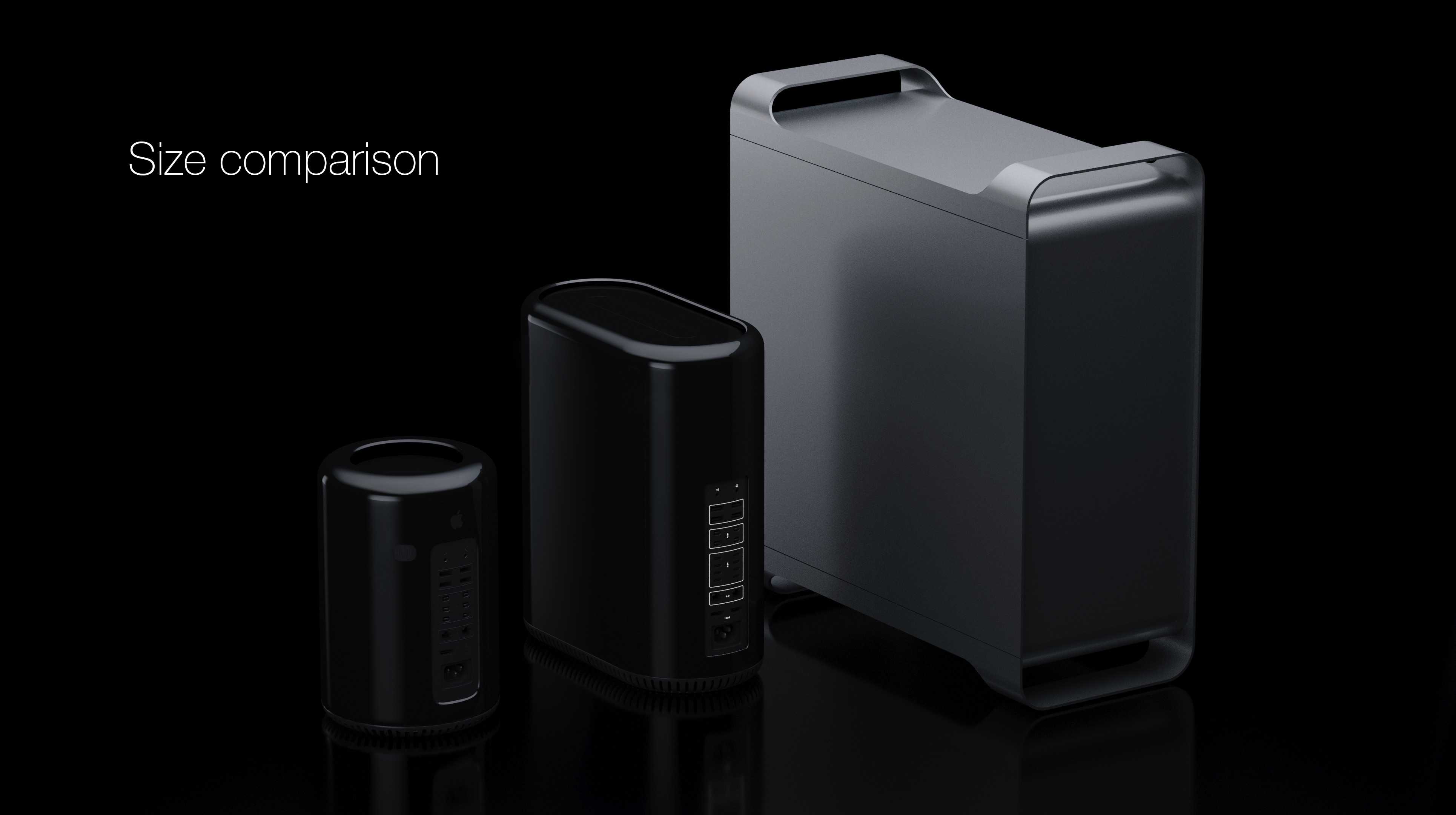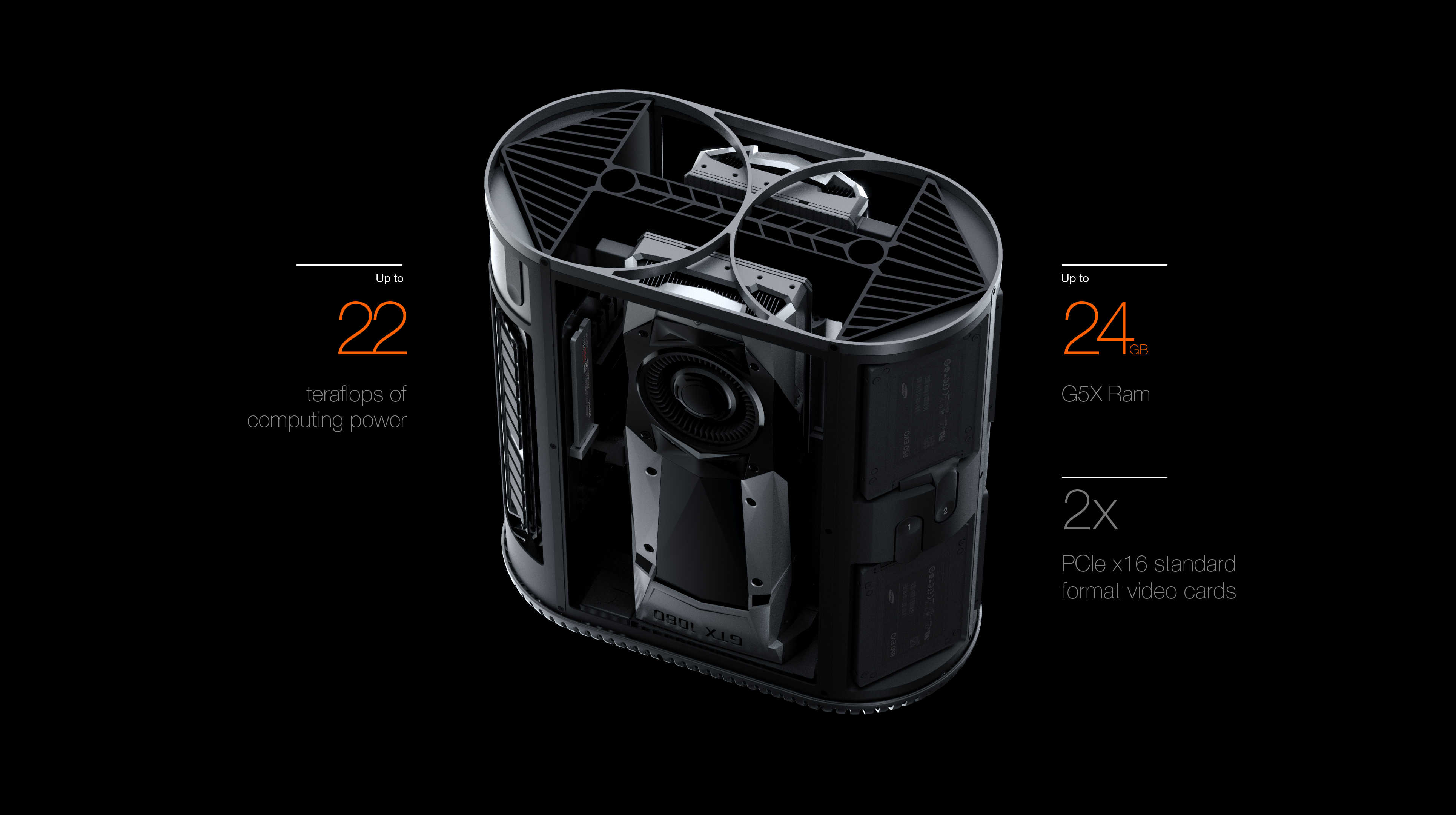What would an Apple Mac Pro 2 look like? Here’s a concept of what may never be.

It’s been four years since we last saw an update of Apple’s ultimate desktop, the Mac Pro. With barely another four to go before this powerful, yet aging professional workstation receives its first hint of an impending vintage status, Apple continues to show “ambivalence”, as Cult Of Mac puts it, in regard to the high-end, “industrial-grade” computing trend, whose popularity peaked in the early 2000’s.
A quick look at current offerings, from Apple as well as all its competitors in the desktop category, hints to a sadly realistic (at least for some of us), scenario, in which a high-cost/poor yields correlation leads to a reality in which no manufacturer is interested in making high-end professional workstations anymore, at least not the way Silicon Graphics used to.
The original Mac Pro was a thing of beauty, often regarded as featuring the best design for a desktop. It was first announced at the world Wide Developers Conference in 2006, and featured an aluminum case not unlike the Power Mac G5, with a few subtle differences.

Then 2013 came, and Apple began to stir controversy with a completely different take on how high-end workstations should look. With that said, a quick search for “SGI O2 moosehead” will takes us back to 1996, when Silicon Graphics began toying with contoured, ultra-compact designs for high-end computers, much like apple did in its transition from the G5-style design to the round bin look we know today. Much like SGI sought to break from the mold of SGI Indigo 2 and Challenge M desktop workstation designs, Apple has done so at the expense of upgradeability.
This may very well be a small part of what motivated graphic designer Pascal Eggert, who took it upon himself to envision what would happen to the Mac Pro, should Apple ever decide to invest resources into a brand new version of this iconic workstation.
Eggert's renderings are remarkably accurate to reality, and mindful of Apple’s extreme attention to detail and Jony Ive’s typical creative process, telling a story about how the Mac Pro should evolve, to appease both home power users, and professionals.
The concept spins off from the latest 2013 Mac Pro, bolstered in size, to a scale halfway the G5-style Mac Pro, and the 2013 version, but considerably taller. Tall enough, in fact, to accommodate two NVIDIA GTX 1080 video cards.
As a matter of fact, the two cards alone take up much of the internal space of this concept, dwarfing in size any other internal component, including the logic board.
As Eggert explains, “...this isn’t entirely thought through — for example, I forgot to turn the video cards the right way for the airflow — but in a way this shows that the Mac Pro could still look decent while also being a product pro users would actually consider buying...”.
Eggert’s concept is actually quite pleasing, including the internal configuration, creating a large space for the dual full-size GPUs by splitting the 2013 Mac Pro into two halves, but as we look better into this design, questions of airflow arise, since cramming two full-size GTX 1080’s into such a tight space requires far more space for heat to dissipate, since it doesn’t look like there would be much room left for any kind of reasonably effective liquid-cooling system, in addition to a power supply powerful, and small enough to provide for the whole system.
So much power requires far more than a hole at the top, and this is why a more “traditional” design, at least according to current technologies, clashes with Apple’s concept of thinness and quiet operations.
Professional workstations are anything but quiet, as every PC builder, from hobbyist to professional, knows, and the amount of fans and heft of cooling methods required to maintain smooth operations on a multi-core, multi-GPU, high-performance system, cannot reasonably afford the luxury of bending internals to the will of design, at least not to the extreme extend Apple has a penchant for.
This is precisely why 2013 was the year when Apple’s interest in making high-end professional workstation peaked, with a fast, and relentless descent to follow.
While to some it might be a hard pill to swallow, but the reality is that building high-performance computers is not a task that should be expected from PC manufacturers, not because such machines would be prohibitively expensive, optimistically above the $10,000 mark, and neither because such machines would have limited market among consumers outside of science labs, and high-end production studios, but simply because these machines already exist, in pieces, scattered across computer stores across the world, waiting to be picked up and put in a shopping cart by those with the skillset, the will, and the need to build their very own rig. This category of customers are not regular consumers, and they are very difficult to shop for, because they are at the bleeding edge of technology, and will not settle for anything out of the box, no matter how beautifully designed, and how powerful. PC building is a multibillion dollar industry surviving thanks to hardware manufacturers’ interest in selling individual components, from mainboards to RAM, to CPUs and beyond, rather than opting for an exclusionary wholesale business model, which would wreck havoc among a gigantic chunk of consumers.
Based on this, should we really hold our breath for a Mac Pro 2? You decide.
Ready to shop?
Looking for the most powerful desktop created by Apple? PortableOne is where you can buy the Apple Mac Pro a production powerhouse for high-end creative professionals.